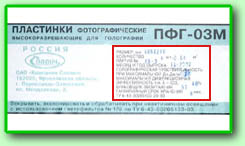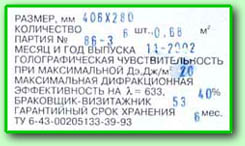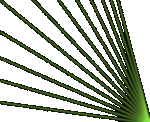|
2. PFG photoplates
Holographic
photoplates differ greatly from ordinary photographic
plates and films for  photography.
First of all, they are mostly sensitive
(sensitized) to the particular spectrum of laser
emission but not to the whole of white light spectrum.
Secondly, resolution of holographic photoplates
is very high. For example, interference pattern
with T period not less than 1micron is registered
on the photoplate in Denisyuk's scheme. Therefore,
resolving power N=1/(T/5) of such photoplates should
be not less than 5000 lines/mm. As you know resolving
power of amateur photo films does not exceed 200
lines/mm. Here is a list of holographic photo plates
manufactured by Slavich Company JSC. photography.
First of all, they are mostly sensitive
(sensitized) to the particular spectrum of laser
emission but not to the whole of white light spectrum.
Secondly, resolution of holographic photoplates
is very high. For example, interference pattern
with T period not less than 1micron is registered
on the photoplate in Denisyuk's scheme. Therefore,
resolving power N=1/(T/5) of such photoplates should
be not less than 5000 lines/mm. As you know resolving
power of amateur photo films does not exceed 200
lines/mm. Here is a list of holographic photo plates
manufactured by Slavich Company JSC.
-PFG-01
- silver halide photo plates for recording transmission
holograms in Leith-Upatnieks scheme. They are sensitized
to red spectrum to record holograms by He-Ne laser.
-PFG-03
M - silver halide photo plates for recording reflection
holograms in Denisyuk's scheme. They are sensitized
to red spectrum to record holograms by He-Ne laser.
-PFG-03C
- silver halide photo plates for recording color
reflection holograms in Denisyuk's scheme. They
are sensitized to emission of He-Ne and argon lasers.
-PFG-04
- photo plates for recording reflection and transmission
holograms on bichrome gelatine. Their resolving
power is more than 10000 lines/mm. They are designed
for recording holograms by argon laser in blue and
green spectrum.
-VRP
(FPR) - silver halide photo plates for recording
transmission holograms in Leith-Upatnieks scheme.
They are sensitized to green spectrum to record
holograms by neodymium or argon pulsed laser.
Let's
consider characteristics of PFG-03 in detail. Photo
plates are manufactured on the substrate of polished
optical glass with 2.65 mm thickness. Emulsion layer
thickness is 7 micron. Photoplates are specially
designed for recording reflection holograms with
large spatial frequency, therefore when synthesizing
emulsion, grain size of silver bromide is small,
it is about 12 nm. Total silver application in emulsion
is not large too - 1.8 gm/sq.m. PFG-03 plate looks
like transparent slightly bluish glass because of
the dye (sensitizer) included into the layer. The
dye increases sensitivity to red spectrum. The emulsion
layer is weakly hardened, therefore photo plates
should be developed very carefully particularly
at water chemical photographic processing. Sizes
of photoplates are from 2x2 inches (52x52mm) up
to 11x16 inches (280x406mm). Photoplates are packed
in plastic tubes 30 items per each (small sizes)
or in cardboard boxes 6 items per each (large sizes).
 There are following
data on the labels: plate size, quantity (in items
and sq.m), run number, production date, sensitivity,
maximum diffraction efficiency for recording by
He-Ne laser (wavelength is 633 nm) and shelf life
(6 months in a fridge). We would like to explain
sense of two most important parameters of photo
plates - diffraction efficiency (DF) and sensitivity
(S). There are following
data on the labels: plate size, quantity (in items
and sq.m), run number, production date, sensitivity,
maximum diffraction efficiency for recording by
He-Ne laser (wavelength is 633 nm) and shelf life
(6 months in a fridge). We would like to explain
sense of two most important parameters of photo
plates - diffraction efficiency (DF) and sensitivity
(S).
DE is measured as ratio of energy of light beam
Ii reconstructed by a hologram and energy
of reconstruction beam Ic, incident upon
a hologram: DE=Ii/Ic. The
more part of energy of the incident beam is transformed
by the hologram into energy of the reconstructed
beam, in other words, the more brightness of holographic
image, the more DE. Usually DE of reflection holograms
recorded on PFG-03 does not exceed 50% for smooth
objects and 30% for diffuse objects.
Photoplate sensitivity S - is a surface density
of energy of recording beam Er in photoplate's
plane which corresponds to maximum DE. S is measured
in J/sq.m. Photo plates have 20 J/sq.m sensitivity
on the given label (see photo). The author proposes
to use other units of sensitivity measurement which
are closer to the real conditions of recording.
These are mJ/sq.cm. According to simple calculation,
value of sensitivity is 2mJ/sq.cm. Practical usage
of the last runs of PFG-03 (87-88 emulsion) presents
the real value of sensitivity 0.5-0.6 mJ/sq.cm and
even lesser.
References
1. Gurevich M.M. Photometry (Theory, Methods, Apparatus).
Leningrad, Energoatomizdat, 1983
-->
|





